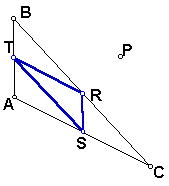
Department
of Mathematics Education
J.
Wilson, EMAT 6680
Discovery Within the
World of Pedal Triangles Using GSP
by David Wise
For more information on GSP, contact the publisher, Key Curriculum Press.
To find instructions on setting up GSP as a helper application
click
here.
This investigation begins with the construction of a pedal
triangle and focuses on the discovery of properties of the pedal
triangle when the pedal point is confined to the centroid, incenter,
orthocenter, or circumcenter. Centers of triangles are a standard
topic in high school geometry courses. Pedal triangle investigations
provide interesting extension problems.
I have provided only discoveries. This investigation could
easily be adapted for students to follow the same discovery path,
or could be altered to investigate one topic with more depth.
Students should be able to complete proofs of, or pertaining to
relationships discovered within this investigation. In addition,
I have only scratch the surface of discoveries based on pedal
triangles. For example, when the three vertices of the pedal triangle
are collinear (the pedal triangle is degenerate), the line segment
is called the Simson Line. The inspiration for this investigation,
which suggests many more investigations pertaining to pedal triangles,
was developed by Dr. Wilson. Click
here to link to his other suggestions for investigations
of pedal triangles and the Simson Line.
I. Constructing the Pedal Triangle
- Construct any triangle ABC by first
using line constructions and then constructing the segments of
the triangle.
- Construct any point P.
- Construct the perpendiculars from point
P to the sides of triangle ABC. Note: Construct the perpendiculars
using the lines of triangle ABC.
- Construct the intersection points of
the perpendiculars to the sides of triangle ABC. Label the points
R, S, and T.
- Construct the triangle RST.
- Triangle RST is the Pedal Triangle
to triangle ABC, where P is the Pedal Point.
- Click here
for the script.
- Click here
for the sketch.

II. The pedal point and the centriod
of triangle ABC are concurrent.
Findings:
- The pedal point P is always located
in the interior of the pedal triangle RST.

- The vertices of the pedal triangle
remain on the sides of triangle ABC, until triangle ABCbecomes
significantly obtuse.

- When the three vertices of triangle
ABC are collinear (triangle ABC is a degenerate triangle), the
vertices of the pedal triangle RST and the pedal point P are
concurrent.

- When the three vertices of triangle
ABC are collinear and two of the vertices are concurrent, two
of the vertices of the pedal triangle RST and the pedal point
P are concurrent and the third vertex of the pedal triangle RST
is concurrent to the two concurrent vertices of triangle ABC.
In addition, the degenerate triangle ABC is divided by the pedal
point P (and the concurrent points to P) into two segments in
which the longer segment is twice the distance as the shorter
segment.

To investigate further, click here for the
sketch.
III. The pedal point and the
incenter of triangle ABC are concurrent.
Findings:
- The vertices of the pedal triangle
RST are always the points of tangency of the inscribed circle
of triangle ABC.

To investigate further, click here
for the sketch.
IV. The pedal point and the orthocenter
of triangle ABC are concurrent.
Findings:
- When triangle ABC is an acute triangle,
the pedal triangle RST is also the orthic triangle of triangle
ABC.

- When triangle ABC is a right triangle, the vertices of the
pedal triangle RST are collinear (triangle RST is a degenerate
triangle) with the pedal point P and two of the vertices of the
pedal triangle RST concurrent to the vertex of the right angle
of triangle ABC. In addition, the segment RST is the altitude
of triangle ABC from the vertex of the right angle perpendicular
to the opposite side.

- When triangle ABC is an obtuse triangle, the pedal point
P is outside triangle ABC. If segments are constructed from the
pedal point to the two vertices of the acute angles of triangle
ABC, a triangle is constructed in which the pedal triangle RST
is the orthic triangle of the constructed triangle. As pictured,
the pedal triangle RST is the orthic triangle of triangle ABP.

To investigate further, click here
for the sketch.
V. The petal point and circumcenter of triangle ABC
are concurrent.
Findings:
- For any triangle ABC, the pedal triangle RST is also the
medial triangle of triangle ABC.



To investigate further, click here
for the sketch.
If you have any comments concerning this investigation that
would be useful, especially for use at the high school level,
please send e-mail to esiwdivad@yahoo.com.
Return
to my homepage.











